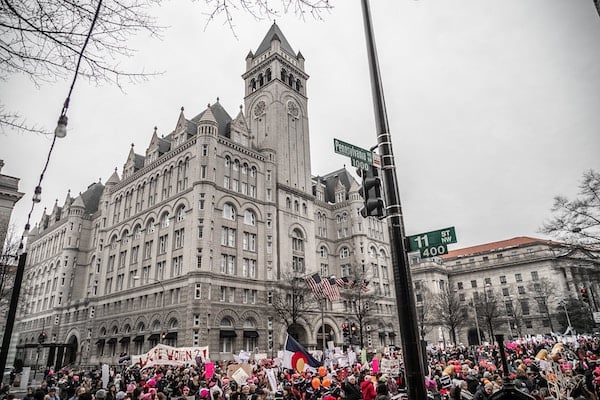Published on
Applying Lessons from Civil Rights Leaders to Move the Needle in Higher Education

Civil rights leaders took on—and continue to pursue—an incredibly challenging mission. In the face of incredible obstacles and social stagnation, these leaders pursued significant social change. While the stakes are different, many higher education leaders are charged with a similar purpose: to improve accessibility, drive social and economic prosperity, and create an equitable and supportive postsecondary environment geared toward addressing the key challenges of some of America’s most underserved demographics.
In this interview, Annica Wayman shares lessons that higher education leaders could learn from the Civil Rights movement, reflects on her experiences as a member of a traditionally underrepresented group in a STEM program and discusses her commitment to create an accessible and inclusive environment for students of all backgrounds.
The EvoLLLution (Evo): What are a few key characteristics Civil Rights leaders, past and present, harness to drive movements that created significant social change?
Annica Wayman (AW): Civil Rights leaders, past and present, are so valuable in helping to progress our society, and have admirable characteristics to facilitate that work. These leaders hold the vision that everyone—regardless of race, ethnicity, or gender—deserves an opportunity to learn, and that this opportunity will drive economic opportunities for all.
These leaders share the qualities of being visionary and thinking big. They imagine possibilities for our society, and think critically about how it could be improved. Along with that, they are optimists and maintain a strong belief that despite the bias in their current time, there is potential for improvement and that people, attitudes and behaviors can change.
Another characteristic they share is the ability to stay persistent and continue to move forward, mobilize and fight. Despite the challenges and the threats to their life, freedom, family, and livelihood, they continue to persist towards fulfilling their vision.
I’m grateful for all that our Civil Rights leaders, including Dr. Freeman Hrabowski III (now president of UMBC), did to enable me to pursue my dreams and education as a child.
Evo: Shifting from strategic to the more tactical, it takes an incredible amount of organization to create social change. How do Civil Rights leaders leverage organizational effectiveness and management skills to deliver that kind of noticeable change for their most vulnerable stakeholders?
AW: If you think back to the experience of Civil Rights leaders in the 20th century, people’s lives were on the line. Children were going to jail, lynchings were happening. Leaders had to think and act in real time, having to do really rapid assessment to determine what direction to move to realize the shared vision. That rapid outcomes assessment is part of what made Civil Rights organizations effective at that time.
There was also a specific focus on leadership development across the various Civil Rights organizations. Key leaders like John Lewis, Jesse Jackson and Andrew Young—among many others—who worked with Dr. King as teenagers, were given room to grow. They became significant leaders and were able to expand the reach of the core movement and bring it nationwide through a variety of channels.
Dr. Hrabowski recalls Dr. King saying, “What you do this day will have an impact on children not yet born.” That’s the spark that was passed on by the Civil Rights leaders to later generations, helping them have a broader impact and achieve the goals of the Civil Rights Act, the integration of schools, and Voting Rights Act, amongst other things that have had a tremendous impact on my future.
Now that we are further removed from the injustices that existed back in the ’60s and before, we don’t want to forget all that they did to get us to where we are today. It’s critical for this leadership development to continue so that the status quo doesn’t take hold, so that we don’t recreate the past, and so that we keep vigilant in ensuring that we move forward and not backward in achieving equality for all.
Evo: When you reflect on your own experience in change-making organizations, how do you balance the importance of skills coming in the door with a shared vision for what you’re trying to accomplish and achieve?
AW: Before returning to UMBC, I was with the United States Agency for International Development (USAID). So I reflected more on organizational effectiveness through this lens. The challenges we were trying to address were similar in nature and require the same type of organizational effectiveness.
When it comes to achieving the mission, taking that time to ensure that you’re on one page with the vision is critical. People are individuals, so they have their individual drive for why they are there and why they’re doing that work. How do you provide them with autonomy to do what is driving them and keep that aligned with the broader vision?
When someone first comes in, they’re going to be looking for more direction. And as they continue to grow and look for more autonomy, that is going to shift.
Evo: Turning our attention to higher ed, what are the key roadblocks that tend to keep underrepresented minorities and underserved demographics out of higher education and STEM programming that tends to lead to better jobs and careers?
AW: As an African American female who majored in Mechanical Engineering at UMBC, and went on to get a Ph.D. at Georgia Tech with a focus on bioengineering, I would say one of the biggest roadblocks I see is the culture—across the university generally but within STEM programs especially—that makes underrepresented minorities feel that they don’t belong.
Sometimes it’s not intentional. But often you’re one of few or the only person of color in your classes. The way that conversations develop in class, the setup of the classroom, the approach that students or faculty may have with you, tend to set a culture in which underrepresented minorities may not feel welcomed.
Secondly—and this is a challenge that exists across the board in STEM, not just for underrepresented minorities—is a lack of exposure to what positive impact students with a STEM degree can have.
This could range from helping with providing better access to healthcare in Sub-Saharan African countries to finding cures for neglected tropical diseases. Or finding lower cost therapeutics for certain diseases that affect more people in developing countries versus developed countries. There are a lot of societal problems that can be addressed through science and engineering.
Another roadblock is the difficulty people in underrepresented groups may experience in becoming comfortable with the possibility of failure in science and engineering. Because legal requirements for all students to have access to equal educational opportunities are still fairly recent, there’s a greater pressure on individual students to achieve success. There’s a feeling that there is no room for failure because I am standing on the shoulders of Civil Rights leaders and my family and many others who have fought hard for me to be here.
When studying mechanical engineering at UMBC, I had a really strong support network consisting of Dr. Hrabowski and other African American students pursuing science and engineering. Enrolling at Georgia Tech to pursue my Ph.D. was a completely different experience, where I faced quite a bit of failure. I went from top of the class and being very confident to feeling at the bottom of the pyramid, which definitely took a toll on my confidence. The failures I was experiencing made me think that this was not for me.
Later, I started to notice that my counterparts took failure less seriously than I did. Having family members and perhaps even parents with Ph.D.s, they were already exposed to the rate of failure within the sciences and engineering. They knew it’s not a reflection on your talent or your intelligence. So over time, I grew a greater resilience and a greater confidence.
Evo: How can higher ed leaders increase access and success for traditionally underserved students?
AW: When working in higher education, you’re working with people who are coming to you because they want to advance themselves, not just their careers. Being visionary for that particular student as well as for, more broadly, the university, and being able to deliver the education that students need to reach their goals is very important.
What I’m trying to do in my current role is create a brand new program that trains students at an undergraduate level on translational science. Translational science refers to taking scientific discoveries and making them into lifesaving solutions. To our knowledge, this is a first-of-its-kind program in the United States. Not only do I need to be visionary about the program, but I also have to be visionary about the students.
We expect that students will come to the program from all kinds of backgrounds. They may have faced challenges or setbacks as a student, or may be juggling many different commitments as they work to earn a degree and progress in their careers. I have to be optimistic and affirming for these students, emphasizing that they can reach their goals. They can have an exciting career designing new pharmaceutical drugs and therapeutics that are going to one day save someone.
This is a characteristic that all higher education leaders, from top administrators to the faculty and staff, need to have because the students need to be surrounded with that optimism to keep them encouraged despite the challenges they’re facing.
Evo: How can leaders leverage these lessons at the micro level to create a movement within a particular division or a program that’s specifically designed to fill a skills gap?
AW: Starting from the top and ensuring that you’re hiring a team that shares that vision with you is a key component that Dr. Hrabowski has done extremely well over the years. When looking at schools in my senior year, I knew that it was important for me as a minority in engineering to have a strong support network. When I met Dr. Hrabowski, he invited me to UMBC and told me about the Meyerhoff Scholars Program, which immediately hit me as the support network I was looking for. He ensured that the faculty and staff all understood the intent of the Meyerhoff Program, so it would truly work as part of a broader UMBC culture of support.
I’m so proud to be back working at UMBC, and when I walk on campus, I see people of different races and ethnicities and all walks of life genuinely interacting about subject areas that matter to them. There is a unifying feel on the campus that Dr. Hrabowski has been working towards for over 30 years. A term that’s often used at UMBC is “inclusive excellence.”
UMBC has been recognized for its innovative education and for bringing students of different backgrounds together to do something that puts them on a level playing field. They have designed classrooms and lessons in a way that allows students to interact on a more equitable basis when they’re talking about science and engineering.
What I love about engineering is that it’s objective, which facilitates diversity and collaboration. This is how they train the faculty and staff and create inclusive, active learning spaces on campus. Faculty and student recruitment staff stress the strength of this kind of culture on campus.
That’s where you are able to leverage those lessons from Civil Rights leaders and make a successful university, delivering equitable opportunities and education for all. In the UMBC environment, you’re not trying to deliver a status quo postsecondary experience. Instead, you’re focused on shifting what higher education is and could be.
This interview has been edited for length and clarity.
Author Perspective: Administrator



